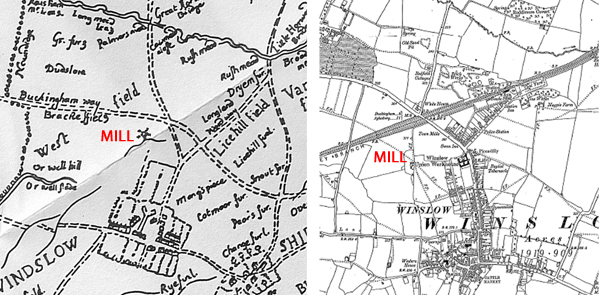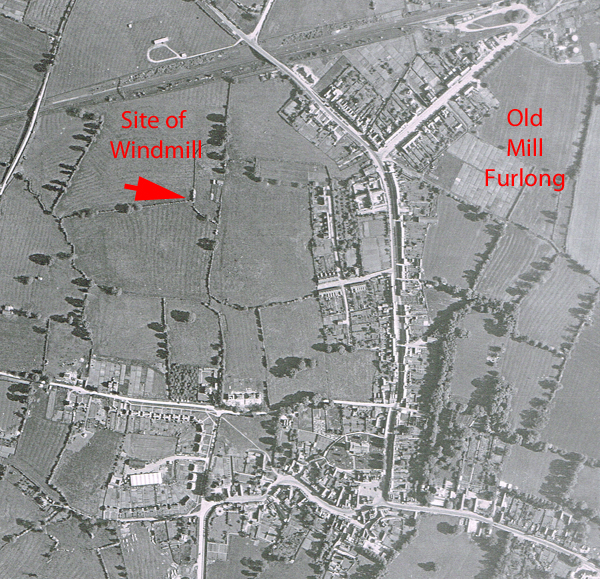
Windmill
The windmill which lent its name to the former Windmill Inn, High Street (now a vet's), can be seen on the 1599 Map of Sir John Fortescue's Estate. It stood on the relatively high land north-west of the town and the enclosure can still be seen on the edge of the grounds of the County Secondary School (now demolished) north and east of the new road called Hazleton. The map below shows that the location of the windmill on the 1599 map matches closely the enclosure on the 1898 map. A windmill is mentioned in the Survey of 1556. However, the site of the mill moved by the early 16th century: it was originally on the land where 110-186 High Street now stand; read more. The 1683 court rolls refer to some land lying between the New Mill and the Old Mill, and there are many references to Old Mill Furlong (roughly in the area where the road of the same name now stands). On the 1599 map, one of the three open fields is called Old Mill Field (to the south and east of the town), but the field to the north and west is called West Field. From the middle of the 17th century its name changed to New Mill Field.

The windmill site in 1599 and 1898
Millers listed in manor court records:
1512: Thomas Miller, Thomas Jakson
1519: Thomas Miller, William Hale
1532: Thomas Thorne, John Bowtye[?]
The 1556 Survey lists Thomas Thorne holding the Windmill by copy of court roll dated 16 Oct 1550, lately in the tenure of Thomas Thorne his father, paying 4d p.a. A Thomas Thorne, perhaps the next generation, was buried in 1604.
John Chinall (d.1619) was a miller according to his inventory. In 1638 the windmill was included in a surrender made by Peter Fige, bailiff of the manor, for the benefit of his son, another Peter Fige. In 1645 Peter Fige sold it (with 1½ acres of land) to Thomas Cooke.
A case in Chancery from 1662-63 concerns the windmill and shows how it changed hands and when a house was first built on the site. The two documents are summarised below.
National Archives, C5/460/124
In 1662 William Chennell of Buckingham, miller, said that in October 1660 he agreed with Thomas Cooke of Nash to purchase the windmill and 2 acres of land. Thomas Cooke would surrender it to him at the next manor court with "peaceable and quiet possession thereof". Chennell agreed to pay £12 12s 6d immediately on the surrender and £60 in 3 annual instalments beginning at Michaelmas 1661. The surrender and first payment were made at the manor court on 8 Oct 1660. Cooke agreed to remove the tenant-at-will (whose name Chennell didn't know) by Michaelmas 1661, but now the tenant claimed to have title to the land from Cooke. Cooke "most unconscionably hath arrested [Chennell] at the Common lawe for the sayd money" due in 1661. Chennell was "already damnifyed to above the
value of Thirty pounds by reason of the said Thomas Cookes nonperformance of the sayd Agreement in delivering or causing to be delivered to your Orator the quiet & peaceable possession of the sayd twoe Acres of Land."
National Archives, C6/162/49
On 8 July 1663, Thomas Cooke answered that he was the brother-in-law of Thomas Cooke of Nash and had acted on his behalf. The mill and land were in the occupation of William East, miller, who was Cooke's tenant-at-will with no claim after Cooke alienated them. They were surrendered to Chennell, who agreed to pay the £60 in full at Michaelmas 1661. East "did erect a small tenement on part of the said two acres, to the end he might the better mannage and attend the said Mill". Chennell "hath promised the said East that he should live and inhabite there during his life".
William Chennell evidently emerged from the court case as owner of the windmill and land, but must have had a tenant or employee to run the mill. In 1666, Ralph Chenall, who was under age, inherited a windmill and 2 acres of land from his father William. Robert Hobcraft, miller, died in 1681 and his inventory included a millstone and sail-cloths; he was the Chennells' tenant. In 1703, John Chennells was in possession of "a mill"; his son John Chennells was admitted to a messuage, a windmill and 8 acres in 1704.
Winslow parish register records the baptism on 5 June 1665 of "Susanna daughter of John Bezile of Eastleige in the county of Glocester, 4 miles beyond Burford, born in the Mill House".
In 1713, John Chennells mortgaged the windmill and 2 acres of land to Thomas Gibbs, baker, for £20. The entry in the court roll includes a list of mill equipment, partly in English and partly in Latin: sails, sail cloaths, stones, boxes, bread-baskets, troughs, star-wheels[?], cogs, braces.
The windmill was held by Joseph Bigg, bricklayer when he mortgaged it in 1722 and when he died in 1741. The mortgagee was Robert Stevens of Granborough, and the property passed to his son Robert and then in 1747 Robert's brother Richard Stevens.
The mill at this time was let to Thomas Hall, who was paying rent of £11 p.a. See his answer in a dispute about Joseph Bigg's property.
The mill was not used after the enclosure of Winslow in 1767 when most of the arable land in the parish was turned over to pasture. The mill appears to have gone out of business somewhat earlier as it was probably one of those destroyed by fire in 1760:
Imperial Magazine 15 February 1760
This night a most terrible storm happened that did prodigious damage upon sea and land. Near Winslow, Bucks, five windmills were burnt to the ground, occasioned by the high wind, which gave them such quick motion that their axletrees took fire.
Winslow Court Rolls 3 October 1762
Taken for an Heriot on the death of Mr. George Savage, the remains of a windmill, valued by Mr. King, carpenter, at five pounds.
Winslow Enclosure Award 1767
George Savage held an old enclosure, the Mill Ground and Garden containing 2½ acres, formerly belonging to the Mill House at Winslow. William Lowndes took this in exchange for Allotment 15.

The site of the windmill is marked on this 1947 view from the air; the site of the "Old Mill" was west of Old Mill Furlong
There was a windmill by the 14th century, as these entries from the Manor Court Books show.
1345: The lord granted to Richard of Cherdesle 16 acres of land from the demesne in Bendensforlong next to the Windmill of Wynselowe, for the next 12 years.
1347: The lord granted to Master William, Vicar of Wynselowe, a pasture called Bubbesgorewey, along with a path next to the Windmill of Wynselowe, abutting on to the demesne land.
Villeins were obliged to use the lord's mill, and there are frequent references in the 14th century to people being fined for not doing so.
The windmill is mentioned in a transfer of property between Peter Fige and his son Peter in 1638.
Some land described as being "between the Old Mill and the New Mill in a furlong called Bubles Gore or Mill Furlong" was bought by Thomas Deely jr in 1683 and transferred to his daughter Ann in 1684.
